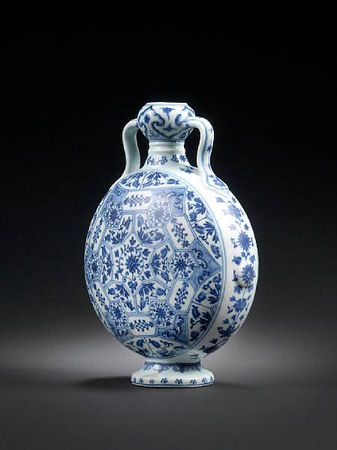A rare Ming-style blue and white moonflask, bianhu, 18th century
A rare Ming-style blue and white moonflask, bianhu, 18th century
Finely painted on the convex sides of the body with a medallion enclosing a brocade design emanating from a central star shaped panel enclosing a lotus blossom encircled by further panels with foliage, lotus scrolls, lozenges and crashing waves, the shoulders painted with pink and lotus sprays, below the handles with lappet terminals rising to the globular garlic-shaped mouth with lappet panels, all supported on a spreading foot with lappet and floral patterns. 24.5cm (9½in) high. Sold for £90,000
Provenance : purchased by Birket Foster (1825-1899), an English illustrator and watercolourist, between 1865 and 1880
The Hill, Witley, Surrey, England and thence by descent to the present owners
Myles Birket Foster, one of England’s most famous Victorian landscape artists and illustrators, was born in North Shields, London, but later, attracted by the picturesque scenery of Surrey, moved to Witley, where he resolved to have a residence there
‘The Hill’, Birket Foster’s large residence built on 20 acres of land, was primarily designed by the artist himself, and was completed in 1863. A great deal of care and planning was put into the internal decoration of the house. William Morris and Burne-Jones, designers and artists involved in the Arts and Craft movement, were commissioned to decorate numerous aspects of the interior, including seven canvases, which formed a frieze around the three sides of the dining room. Birket Foster was also a keen collector of European and Oriental porcelain. His love and collection of porcelain is well recorded. A series of documentary photographs taken of the interior of the Hill between 1865 and 1880, as illustrated by J.Reynolds, Birket Foster, Batsford, 1984, show how various porcelains, including an extensive collection of blue and white, were displayed on every available surface. In one image, the present moonflask can be seen on top of a display cabinet.
A painting by the artist entitled ‘The Old Curiosity Shop’, which sold at Christie’s London, 28 November 2000, lot 56, also shows two blue and white moonflasks, which are believed to have been painted after the present example. As noted in the catalogue text, whilst the interior illustrated in the painting is not recognisable as belonging to The Hill, a number of features from the property, such as the small stained-glass window panel, have been absorbed into the composition. Porcelain items from Birket Foster’s own collection have also been identified as having been used in the painting, such as a Grès de Flandres inkstand and a puzzle jug. The present blue and white moonflask in this sale has also been incorporated in the painting, albeit twice, as visible by the two blue and white vessels on the top of the armoire in the upper right hand corner of the painting.
When Birket Foster left ‘The Hill’ in 1894, due to ill health, a large proportion of the collection was sold at Christie’s London, 30 April 1894, where the 115 lots were entitled ‘A valuable collection of Old Nankin Porcelain, Grès de Flandres, Majolica and Enamels’. A further sale of his porcelain collection was held at Christie’s London, 1 December 1921.
The form and design of the present lot emulate those of Yongle moonflasks, such as the example in the Palace Museum, Beijing, illustrated in The Complete Collection of Treasures of the Palace Museum: Blue and White Porcelain with Underglaze Red, Hong Kong, 2000, Catalogue no.39, and another at the British Museum, illustrated by R. Krahl and J. Harrison-Hall, Chinese Ceramics: Highlights of the Sir Percival David Collection, London, 2009, p.27. The origin of the design is derived from Islamic metal wares with geometric design.
Compare a very similar moonflask to the present example, dated to the Yongzheng period, in the Palace Museum, Beijing, illustrated The Complete Collection of Treasures of the Palace Museum: Blue and White Porcelain with Underglaze Red (III), Hong Kong, 2000, fig.99.
Related moonflasks with brocade design with Qianlong marks and of the period were also decorated in underglaze red and in overglaze gold red, as illustrated by Soame Jenyns Later Chinese Porcelain, London, 1971, pl.LXXXVI(1). A related unmarked blue and white 18th century moonflask was sold at Christie's Hong Kong, 30 October 1995, lot 668.
Bonhams. Fine Chinese Art, 14 May 2009. New Bond Street www.bonhams.com

/https%3A%2F%2Fprofilepics.canalblog.com%2Fprofilepics%2F1%2F0%2F100183.jpg)
/https%3A%2F%2Fstorage.canalblog.com%2F03%2F02%2F119589%2F96711876_o.jpg)
/https%3A%2F%2Fstorage.canalblog.com%2F11%2F31%2F119589%2F94773502_o.jpg)
/https%3A%2F%2Fstorage.canalblog.com%2F20%2F83%2F119589%2F94772815_o.jpg)
/https%3A%2F%2Fstorage.canalblog.com%2F26%2F72%2F119589%2F75604929_o.jpg)
/https%3A%2F%2Fstorage.canalblog.com%2F59%2F60%2F119589%2F26458628_o.jpg)






/image%2F1371349%2F20240416%2Fob_2a8420_437713933-1652609748842371-16764302136.jpg)
/image%2F1371349%2F20240414%2Fob_83ee65_2024-nyr-22642-0954-000-a-blue-and-whi.jpg)
/image%2F1371349%2F20240414%2Fob_15808c_2024-nyr-22642-0953-000-a-blue-and-whi.jpg)
/image%2F1371349%2F20240414%2Fob_e54295_2024-nyr-22642-0952-000-a-rare-blue-an.jpg)